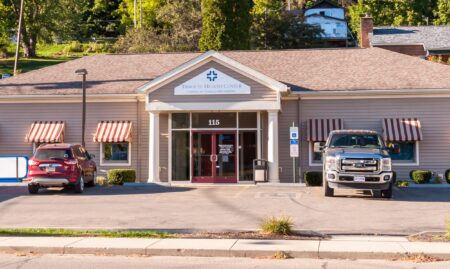Higher tariffs on nearly all major U.S. trading partners are piling pressure on farmers already struggling with soaring agricultural supply costs and elevated rates.
For April Hemmes, a fourth-generation farmer on land her family has worked for almost 125 years in north-central Iowa, life is guided by a simple philosophy: “Prepare for the worst and hope for the best.”
It’s a mindset that has helped her navigate extreme weather, market shocks, and trade disputes.
But this year, Hemmes said, feels different: President Donald Trump’s recent tariff hikes on nearly all major U.S. trading partners have escalated a trade war, fueling uncertainty that is hard to prepare for.
“If there’s all this uncertainty out there, how can we plan? We need a path forward,” Hemmes said. “It’s like changing a tire while we’re still driving down the road.”
U.S. farmers had to navigate a trade war during Trump’s first term, but did so after years of rising commodity prices and government aid.
During the first trade war, Hemmes, a soybean and corn farmer, was able to reduce her debt and invest in new equipment, giving her a cushion and leaving her in “pretty good shape.”
However, this second Trump trade war comes at a time when farmers are in a more vulnerable financial position.
Over the last four years, grain prices have been on a downward trend. Soybeans — a major U.S. export and a pillar of the Midwest economy — have lost 34 percent of their value on the international market. Net farm income, while still above pre-pandemic levels, has declined for three consecutive years.
At the same time, input prices for fertilizer, fuel and other essential supplies have surged over the past five years, squeezing farmer profit margins and putting added strain on operations.
“The big difference between the first trade war and now is our input prices. They’re a lot higher than they were,” Hemmes said.

Borrowing has also become significantly more expensive for farmers, as the average interest rates charged on loans for land purchases and farm operations have increased by over 40 percent since 2020.
“I’ve never seen a time where the level of policy uncertainty is as high as it is right now,” said Patrick Westhoff, director of the Food and Agricultural Policy Research Institute (FAPRI) at the University of Missouri.
“You have all the normal uncertainties that farmers face just because of weather and so on. Now you’ve got this huge policy uncertainty as well. It may turn out well, or it may turn out very badly, and we just don’t know right now.”
Westhoff said the financial health of farmers facing this second trade war varies by sector, with crop producers in a challenging position, while the cattle sector is faring better thanks to higher prices.
“We’ve seen net returns to crop producers fall back to levels we hadn’t seen since before COVID,” Westhoff said. At the same time, he said, fixed costs are much higher, and land and machinery prices are up.
“At some point, something has to change. Either they have to get more income or they have to reduce some expenses.”
Fertilizer is one of a farmer’s most significant expenses and has sharply increased.
Ammonium fertilizer, used heavily for corn, increased by more than 15 percent over the past five years. Phosphorus and potassium, essential for soybeans, rose by over 10 percent, according to Farmdoc, a research initiative from the University of Illinois’ Department of Agriculture and Consumer Economics.
Diesel, vital for equipment and transport, has seen the second-largest price increase.
“Farmers spend a lot of money before we even put a seed in the ground. We have to borrow a lot of money before we even plant,” Hemmes said.
Farmers have made it through the year relatively well, Hemmes added, mainly because most purchases for the harvest were made the previous year, before the trade tensions arose.
“We’re kind of holding our breath for this fall … that’s when it will hurt the most farmers,” Hemmes said.
Bigger bills, tighter margins and loans farmers can’t repay
By late 2024, farmers were finding it much harder to borrow money. Bankers reported farms had less cash on hand and weren’t expecting enough income in 2025.
Chad Hart, a professor of economics at Iowa State University, said farmers are in a tough spot: High costs and low crop prices force them to take on more loans, but it’s getting harder to pay them back.
Farmers are applying for more loans than they did a year ago, according to the Federal Reserve Bank of Chicago, which tracks agricultural lending in Iowa, Michigan and most of Illinois, Indiana and Wisconsin.
At the same time, the index of repayment rates for non-real-estate farm loans has declined year-over-year for the sixth consecutive quarter, suggesting that many farmers are struggling to catch up, even as they take on more debt to stay afloat.
“Loan repayment has dropped,” Hart said. “A lot of this action is due to just the general decline in crop income over the past couple of years, which started before the trade fight.”
Meanwhile, agricultural loan interest rates have soared to historic highs, well above the levels farmers faced during Trump’s first trade war, making credit more expensive just when many need it most.
Part of the pressure stems from a political clash in Washington. Trump has repeatedly urged the Federal Reserve to lower interest rates, arguing that Americans need cheaper credit. He has even threatened to remove Federal Reserve Chair Jerome Powell.
However, the central bank, designed to operate independently, has resisted political pressure.
Federal Reserve officials say they are weighing the inflationary risks of the tariffs and prefer to wait for more economic data before adjusting rates. They also worry that yielding to White House demands could damage the institution’s credibility.
Hart said the current downturn isn’t solely the result of tariffs, but rather the outcome of several compounding pressures. As the Federal Reserve raised interest rates to curb inflation, borrowing costs for farmers also rose. Combine those higher financing costs with falling commodity prices from oversupply, and now renewed tariff concerns, and “you get a recipe for a depressed market,” he said.
A fragile truce on tariffs is likely temporary
After months of economic fallout, the U.S. and China reached a temporary truce that took effect June 11, cutting tariffs from record highs of 145 percent to 55 percent on Chinese goods and 10 percent on U.S. exports.
Although tensions with China have eased, tariffs on other major trading partners, announced in April, have only been paused until July 9. The truce is widely seen as fragile and temporary.
Hemmes said one of the consequences of the first trade war was that it opened the door for South American countries to enter the Chinese market, especially Brazil, which has become its leading soybean supplier.
Although the U.S. no longer sells the same volume of soybeans as before, “you cannot discard how much China buys,” even as the industry works to diversify its markets in other Asian countries, Hemmes said.
“We need trade with Mexico and Canada, too,” Hemmes added. “That’s why I think the reciprocal tariffs are going to hurt us more. We get fertilizer from Canada, ag chemicals from China, at least some of them. We get parts and products made in Mexico.”
‘Our deal with China is done… Relationship is excellent!’ – President Donald J. Trump pic.twitter.com/6NbYDtxuAk
— The White House (@WhiteHouse) June 11, 2025
As planting season got underway in April, many farmers were on edge about the ripple effects of U.S. trade policy. A majority of farmers said they expected current tariffs to hurt their bottom line this year, according to the Ag Economy Barometer from Purdue University and the CME Group, which surveyed 400 producers from April 14 to 21.
Farmers expressed particular concern about rising costs and limited availability of key supplies, especially fertilizer, crop chemicals and machinery parts.
However, while 44 percent said they anticipated a negative impact on farm income in 2025, and 53 percent feared continuing supply disruptions, 70 percent said they still believed that higher tariffs could ultimately strengthen the U.S. agricultural economy.
The same study, conducted a month later, also found that producers were more optimistic about both current conditions and future expectations.
“One of the drivers behind this month’s shift in farmer sentiment appeared to be a much more positive view of the U.S.’s long-run agricultural trade prospects,” the report said.
This shift in tone may reflect what Financial Times commentator Robert Armstrong calls TACO, short for Trump Always Chickens Out. The term describes a pattern in Trump’s trade policy: announcing sweeping tariffs that trigger economic shock, panic and stock market drops, only to reverse course later with pauses or reductions that help markets rebound.
“I think markets have become a bit skeptical about what’s actually going to happen,” Westhoff said. “So we saw in the case of the USMCA countries, Mexico and Canada, that, at least right now, tariffs don’t apply to them when it comes to agricultural products.”
He added that with those countries and the European Union — three of the most important trading partners for the U.S. farm sector — trade remains unchanged on the agricultural front.
However, Westhoff warned that the market reaction could be severe if the high tariffs move forward.
“If we get to July 9, or whatever the magic date ends up being, and we do indeed impose those very high tariffs and countries respond,” he said, “then we’re going to see a big market disruption.”
Investigate Midwest is an independent, nonprofit newsroom. Our mission is to serve the public interest by exposing dangerous and costly practices of influential agricultural corporations and institutions through in-depth and data-driven investigative journalism. Visit us online at www.investigatemidwest.org.




:max_bytes(150000):strip_icc()/Diseaseplaybookksouthernrust-b5873b78fd1949cab74ab000f2db061b.jpg)








